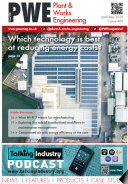Are your VSDs running at maximum efficiency?
Published: 12 April, 2017
While variable speed drives (VSDs) provide an important energy saving technology, Mitsubishi Electric’s Matt Handley questions how many of the installed base of drives are actually set up to run at their maximum efficiency.
Energy efficiency is now a prime consideration for machinery designers, plant engineers and finance directors - with a seemingly constant stream of new legislation designed to encourage industries to reduce their energy usage. As a result there are many technologies available that will now help organisations optimise their energy requirements and reduce their carbon footprints. Is all the applied technology fully optimised though?
It is a frequently quoted statistic that electric motors account for 60% of UK industrial energy usage. It is equally well known that fitting a variable speed drive to control the speed of a motor can save energy – so much energy in fact, that the purchase cost is usually recouped within 16-18 months. Importantly, a variable speed drive also allows users to fit motors sized closer to their typical duty, affording further energy-saving potential.
Today there are hundreds of thousands of variable speed drives installed in countless applications across the country, saving users many thousands of pounds in energy costs. But are end users getting the most out of their variable speed drives? Are they reaping all of the energy savings that they could be? How many of these variable speed drives are actually set up to run at their maximum efficiency?
It might be assumed, for example, that having fitted a variable speed drive, you have achieved your energy savings potential – end of story. The drive may certainly be optimising the speed of the motor by matching it to the requirements of the application. In high duty pump and fan applications for example, this will mean taking advantage of the inverse square law of speed to energy consumption to deliver some significant savings in energy use.
However, to really deliver the maximum energy savings, variable speed drives have to be properly set up at the commissioning stage; this can be as simple as activating one parameter to turn the drive intelligent energy saving mode on.
Where to start looking…
The first area to always look at is nature of the load i.e. is it constant torque or variable torque. The drive can then be adjusted to match its output to the load, thereby maximising the available energy savings. While a drive in constant torque mode will still save energy compared to having no drive on the motor at all, optimum savings will only be achieved in variable torque mode if the connected load is a pump or fan, although it must be stated that some types of pump require the constant torque setting. This needs to be set up when the drive is installed; again this is normally as simple as adjusting one parameter.
Further, many variable speed drives have specific energy-saving modes, with dedicated algorithms tailoring the profiles of the output to deliver greater optimisation.
Some users may have shied away from enabling such energy saving modes on variable speed drives, as historically they could make the drive sluggish to respond to changes in the load. However, this is no longer the case, with best of breed products incorporate technologies that will eliminate the problem.
And the survey says…
It is also fair to say that energy optimisation is a constantly moving target. That means ongoing monitoring of energy usage is vital for identifying areas ripe for optimisation. Even more fundamental than that is the need to perform a post installation survey once a variable speed drive has been fitted.
While there is a plethora of energy saving calculation tools that can make the case for fitting the drive in the first place, these tools make a variety of assumptions that may not always be accurate against real world operating conditions. While the tools certainly provide an indication of how much energy can be saved and show estimated payback times, only a detailed post installation survey can highlight real energy savings and show opportunities for further optimisation.
We can see, then, that while variable speed drives offer numerous opportunities to save energy – and are demonstrably doing so in a wide range of industries and applications – spending a little time to set up the technology correctly will deliver so much more.
Hand on heart it’s impossible to tell how much more energy users could be saving if they really optimised their drives nationwide. What we have seen is that even after a VSD has been fitted, we can often increase energy efficiency by 10% or more quite easily. It also isn’t unusual to be over 10% which if you compare that figure to the relatively small gains in motor efficiency on offer by upgrading from an IE2 to IE3 motor for example, it really is substantial. The irony is that the capability is often already there, it just needs switching on.
For further information please visit: gb3a.mitsubishielectric.com






